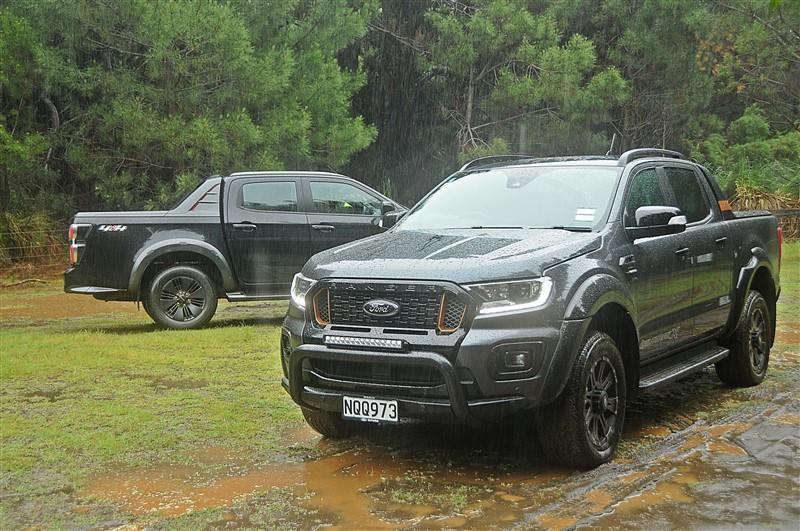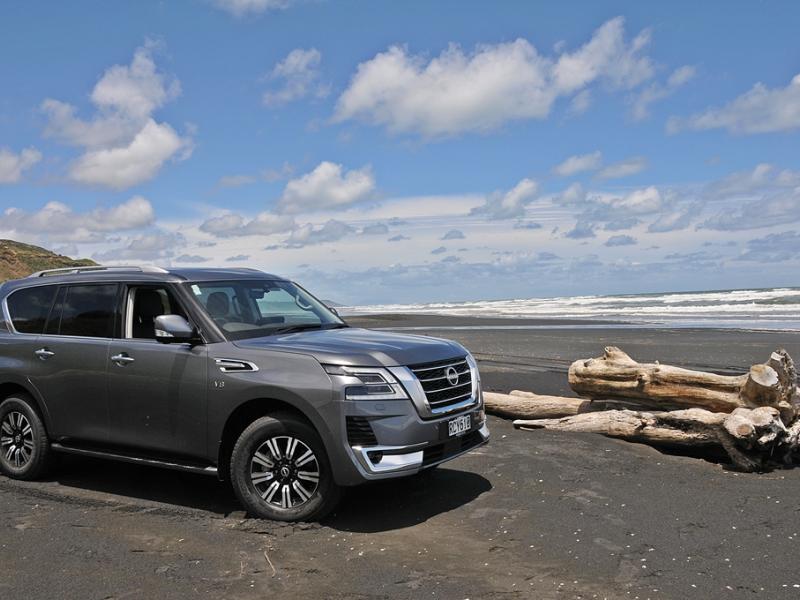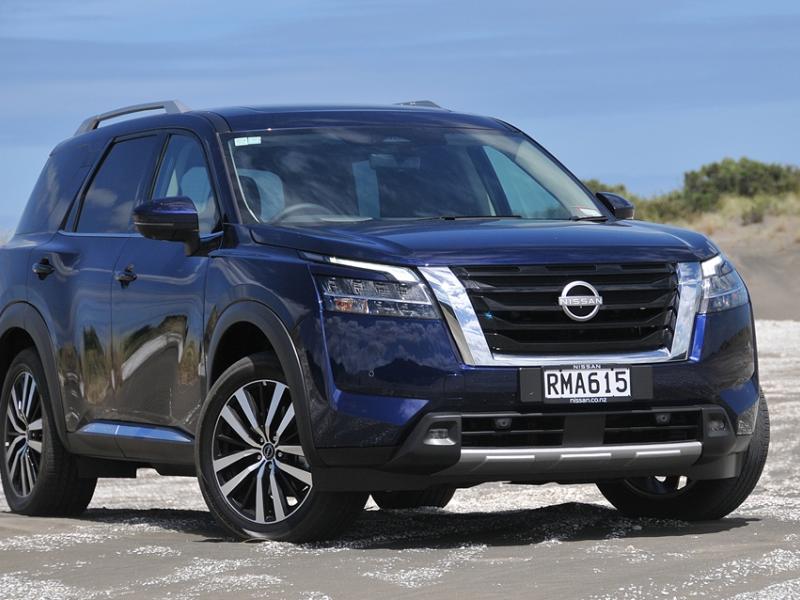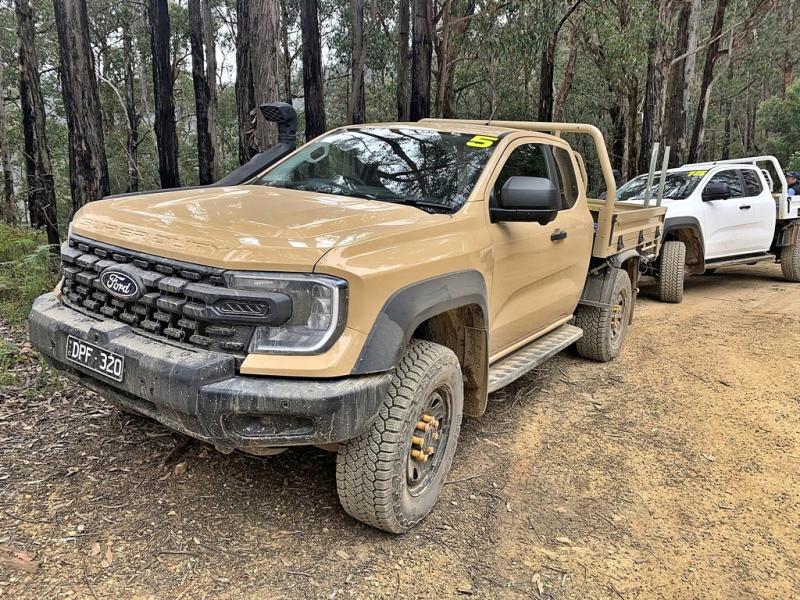In which Company Vehicle editor Sean Willmot and NZ4WD editor Mark Baker pit the ‘all-time champion’ against a young contender, throwing abysmal weather into the mix to work out which should stand on the podium.
“I am the Greatest” – Muhammed Ali coined one of the most famous quotes in sporting history when he went up against Sonny Liston in 1964. Ali – referred to by some as the Louisville Lip - had a way with words that few sports personalities have come close to rivalling. More to the point, his pre-match sledging was backed up by devastating form in the ring.
The same might be said of Ford’s Ranger. Champion of the New Zealand ute world, multi-awarded, its trophy cabinet groaning with cups and plaques and accolades. A heavy-hitter in the driveway and on the land. The Ranger is New Zealand’s best-selling ute and month by month usually the top-selling vehicle overall, competing with Toyota’s Hilux for the title. Over the ditch the Hilux is ahead, making Kiwi motorists pretty much unique in Ford’s world.
But there’s always a young contender waiting in the wings, looking to topple the King. Eventually even Ali was forced to hand over his crown.
Now the moment has come, and we choose Isuzu’s new D-Max to stand nose to nose with the champion. A sensation on the rise, and transformed in its latest form with its all-new base, extensive attention to driving dynamics and of course Isuzu’s comprehensive safety specification, which the company says makes the new D-Max the safest ute ever. It scored a perfect five stars in the latest ANCAP test; the Ford Ranger also has a five-star rating but it’s based on the 2015 testing regime.
It’s an interesting prospect. The Ranger laid on by Ford is its new Wildtrak X, a high spec ‘shiny’ that may well be the best Ranger ever. From its bronze-nostrilled grille, along its gloss black wheel-arch extensions and colour-accented ‘sailplane’ and lockable roll-top wellside cover the Wildtrak X is instantly recognisable but also fresh, thanks to additions like a front nudge bar and light-bar and Ranger’s signature ‘shield’ on each front guard. This is our most popular ute (1629 went out the door in October) and it regularly trumps the overall sales rankings as well. It is simply the vehicle that best suits the Kiwi work and play lifestyle.
• Tow the boat, stick it in the water, drag it back out and head home?
• Drag the caravan away to bush or beach and back?
• Haul tools and timber to the building site?
• Get to that work in progress meeting downtown?
• Fill in for the courier that forgot to come pick up urgent packages for delivery to a client?
• Claw your way up a slippery clay track in the Coromandel – just to see what’s at the end?
For almost a decade, the answer to the question – any question – has simply been Ranger. Small wonder that this country favours the Ranger in its many forms over anything else. The battle between Ranger and the Toyota Hilux has been long drawn out and spectacular, but now there’s a new contender for the crown.
Isuzu’s D-Max goes toe to toe on spec and between Ranger and D-Max there are common features that create a true ‘match’ going into the fight.
Both, of course, are powered by turbodiesel four cylinder engines. Ford wrings more power and torque out of a smaller engine using a bi-turbo setup with variable-geometry high-pressure and fixed-geometry low-pressure turbochargers.
D-Max goes the lower stress route with a bigger capacity four cylinder engine that endows the truck with an entirely different character under acceleration.
Common ground includes tyres, wellside closures, and funnily enough price.
Both the D-Max and Wildtrak have 265/60 Bridgestone Duelers on 18-inch wheels and both feel well suited to the sidewall height. The wheel/tyre combination is handy – it enables us to concentrate on the vehicle’s driving dynamics without wondering if different tyres may have put one or other at a disadvantage as they ‘step into the ring’.
Instead we are able to focus on test criteria including on-road manners, off-road ability, ergonomics, design and of course subjective measures that gauge how well each vehicle might fit our lifestyles.
The final common point is price. Ranger Wildtrak X is priced exactly the same as the D-Max X-Terrain.
We could have included the Hilux in this test, and would have been happy to do so but there simply wasn’t a vehicle available. That has as much to do with global supply chains disrupted by Covid as it does any post-ute-tax resurgence. Besides, three in a boxing ring isn’t sporting!
The best of times to test the best
To throw a literary reference into the mix, it was the best of times, it was the worst of times. Best for ducks, worst for a two-truck test. Or was it?
We love doing these tests in bright sunshine: blue skies, happy images showing trucks at their best. In the real world, people expect these vehicles to function at least as well in all conditions, and even more importantly to do so without issue or complaint. When New Zealand is beset by winter floods, spring floods or summer floods a 4WD really comes into its own.
These are situations where a diesel double-cab 4WD is a priceless asset.
On that topic, the Ranger and D-Max both have an impressive 800 mm wading depth and their websites both offer excellent short instructional videos on safe water crossing practices.
So when it came time to test the two utes, a weather forecast that promised two days of heavy rain was simply a fresh challenge issued to the title prize-fighters.
Lockdown rough-roading
So given the Covid borders were still ‘hard’, where to go? Hunua, where the gravel road and track access has been clamped down to the barest feeder roads leading to car parking for the mountain-biking and hiking enthusiasts? Maraetai, where a tiny strip of shell-flecked sand was hardly going to waken these giants of off-road? Muriwai? Done to death, and not very safe in a storm. Woodhill? The excellent 4WD park was certainly an option, but one we will reserve for another day because it’s a big road tour to get to decent 4WD-ing and – in terms of the rest of the forest – access is locked down at the moment.
We went west. South west – down that slippery narrow ribbon of tarmac that leads into Waiuku Forest. There we would find potholed gravel roads, wet sandy tracks, and some decent standing water to visit.
The rain was horizontal on the way into the forest. It’s surprising the local farmers don’t have a permanent lean when the weather comes from the west and off the sea most days. The trees certainly do.
Having had our fill of rain-soaked pine forest tracks, we set our sights on civilisation. We’d also hoped to catch up with some local tradies at the residential subdivisions currently being laid over green paddocks at Opaheke on the edge of Papakura in South Auckland, but when we got there they had fled.
“Work in the rain? Maaaate y’dreaming.”
Such a pity – with two of the construction trade’s fave utes in hand it would have been great to find out what the ‘front line’ thought of them.
So a final run up through the Hunua Gorge took us instead to the waterfall car park for a think about what we had learned.
Into the ring
The similarities of the two utes are as striking as their differences, and the chief standout among the spec sheet differences is engine size. Ranger has a 2.0-litre diesel, D-Max a 3.0-litre.
Many DDC ute makers now go the former route, using smaller-capacity engines with high outputs to stay on par with bigger units. Often this is to create a lower-emission ‘Euro-compliant’ engine.
The turbochargers on Ranger’s diesel engine work sequentially to deliver 500Nm of torque through a 10-speed auto transmission that is also used in the Mustang and F150.
Isuzu’s approach subscribes to the old ‘no substitute for cubic inches’ approach beloved by drag racers for decades. The Isuzu’s engine draws on that company’s long history of engineering for the truck industry. It is an innovative ‘sandwich’ design, with a cast iron centre section around the cylinder bores where strength is critical, an aluminium alloy cylinder head, and a separate aluminium alloy lower section that cradles the crankshaft.
In independent overseas tests the Ranger recorded a 0-100 km/h time of 9.2 seconds; the D-Max 10.8.
Likewise with fuel efficiency: Ford quotes 8.2 litres per 100km on the combined cycle for the Bi-Turbo; Isuzu 8.1l/100km
In the horrible rain-lashed test weekend we didn’t quite get down to the stated economy figure for either truck, but then they were not being driven with an eye on fuel efficiency. Owners doing a lot of rushing around in the rain with the aircon going full blast should expect 8.4-8.9l/100km from the D-Max; around 9.2 from the Ranger.
The different engine styles do render the driving experience quite distinctive. Isuzu’s truck feels strong down low, and its greater capacity addresses the disparity between its six-speed auto and the Ford’s overdriven ten-speed.
Off-road, both engines are well equipped to overcome available grip and activate the onboard electronics. With classic diesel torque ‘plateaux’ happening at very low revs these trucks both feel quite unstoppable.
This could also be an issue given that they are on-road rubber because it becomes possible to go a long way off-road before greasy footings stop play. And then what?
All is not lost. In both cases there’s a lockable rear diff to bring into play that will help get the truck unstuck.
Ranger’s 12.7-metre turning circle on a 3.2-metre wheelbase is workable off-road. D-Max has a 12.5-metre turning circle on a wheelbase of 3.1 metres which is slightly better – but both throw these figures out the window if 4WD is engaged.
Both trucks have an impressive 800mm fording depth which we opted not to try out in the rain-lashed depths of Waiuku Forest.
Fronting up to a bank or dropping into a washout, the two trucks are almost identical at the front, with approach angles of 29 and 30 degrees – but the D-Max is ahead at the back by four degrees, meaning less drag-and-scrape on churned-up tracks.
Tested
Mark says: The Ranger in Wildtrak X form once more underscores the capability of the product. These trucks are where they are by design, not accident, so the X ‘package’ should be more of a focus here. The new alloy wheels, the sailplane, the power roll-top on the well-side. The slightly toned down Wildtrak styling, the gloss black design elements, the use of accents in ‘Saber’ gloss. But most of all a nudge bar and LED light-bar at the front; the latter of course being for off-road use only.
Dynamically, the latest Ranger is as accomplished as ever. There is a clear and simple reason for its popularity: it’s good. On-road or off, town or country, this is a lot of ute for the money.
A strong performer on wet tarmac, the Ranger requires more driver ‘engagement’ than its fresh new rival. I did get the ABS going a couple of times when approaching corners on wet tarmac, but balancing that is the truck’s steering which gives much better feedback than older versions.
The road-oriented tyre package serves for almost all uses and compared to an all-terrain or mud-terrain tread is blissfully quiet on the motorway. If we’re honest, almost all Ranger users will spend a lot of their time on tarmac – but need that off-road ability for weekend adventuring.
My personal preference would be to get the Wildtrak X rather than the Raptor, even though the latter has a tougher look. The Wildtrak gets the benefit of adopting the Raptor’s engine and much of its development effort and wraps it in a slightly more discreet package.
Again for personal preference, deleting the sailplane and roll-top and adding a canopy would make it an even more appealing proposition, able to lug big square loads in weatherproof security.
My overall rating:
4 out of 5 - Mark Baker
Sean says: Physically, the Ranger looks considerably larger in every respect when compared to the D-Max. This gives an observer both the impression of the ute’s ability to go anywhere and its commanding market leadership position. The subtle copper highlights which mark the Wildtrak X are well executed, powerful enough to differentiate the X as something special, but subtle enough to demonstrate maturity/longevity. The embellishments are not frivolous but well thought out.
Drive on tarmac. The Ranger feels a little ‘soft’ on tarmac, but in a good way.
It doesn’t feel like a truck, it feels more refined than that, especially on coarse chip. This is where the Ranger’s suspension comes into its own, keeping the driver in touch with the road conditions but demonstrating high levels of passenger comfort. On smooth tarmac, Ranger’s suspension feels slightly less connected.
In off-road terrain situations Ranger demonstrates the characteristics which put it in its market leadership position. It’s confident on dirt, sand, gravel and that most horrible of surfaces, wet pine needles. The variety of challenging surfaces positively demonstrates the excellent and predictable combination of the 10-speed transmission and the twin turbo engine.
Ergonomically speaking, there is very little wrong with the Ranger except to say that the instrumentation and controls have come to the end of their fresh life. That’s OK though as the current arrangement has served Ford well, since 2011 in fact, while the competition has been freshening interior instrument design and layout over that time. And Ford is of course, just unveiling a new generation of Ranger with a redesigned interior.
Easy connectivity through SYNC3 is brilliant. Phones sync easily and without the Nana ‘’you must be in park, you must have the handbrake on’’ restrictions. SYNC3 intelligently asks if you are the passenger (yes/no) and then allows linkage.
In a very succinct analysis, Ranger is the market leader it is because Ford designed it to be such right from the start, with every element of its construction apparently built to complement every other to make the sum greater than all of its parts.
My overall rating:
4.5 out of 5. - Sean Wilmott
Mark says: D-Max has been around in one form or another since 2003. The big leap forward came with the current version, which amps up the on-road manners and retains off-road performance.
The D-Max is an easier drive in most situations than the Ranger. Jumping from one to the other is informative – in fact those looking at either ute really should try to drive both ‘back to back’ if they can.
In terms of driving dynamics the D-Max is engaging and subjectively it feels somehow ‘lighter’, turning into corners crisply on wet tarmac with clear feedback through the steering wheel and then accelerating away cleanly without getting the DSC light flashing.
Again this is to some extent about the package. Those who have already driven the new D-Max knows what it’s about. The X-Terrain has its own design of 18-inch alloy wheel, glossy gun-metal exterior trim accents, lashings of leather in the cab and a couple of useful storage bins under the split-fold rear seats.
Both these utes have well considered dashboard displays – but the D-Max is my subjective winner here, its Multi Information Display (MID) with digital speedometer, safety information, fuel economy and range, odometer and trip information, conveyed through a colour TFT display. Simple, clear, job-focussed. The integration of the multi-media infotainment screen in the centre of the dash also gets my thumbs-up.
Styling is totally subjective, but the fresh face and flanks of the D-Max probably win the day for me, though I have less warm feelings about the look of those alloy wheels and their practicality off-road. Painted rims are no longer my favourite when tackling tracks with muddy wheel channels. There’s nothing worse than tearing paint off nice new alloy wheels.
Like the Ranger, the D-Max would be even better if we took off the roll-top and sailplane and added a colour-matched canopy. That would add full-on family appeal to an already attractive new truck.
My overall rating:
4.5 out of 5. - MB
Sean says: Can D-Max challenge the champion? The short answer is ‘no’ but it won’t be for lack of trying. Core to the success of the D-Max is that it has the cojones to do what the Ranger can. But Isuzu lacks Ford’s car building sophistication, which shows up in the Ranger.
It is interesting that on paper our two protagonists look like line ball competitors, but there is a certain something which keeps the Ranger just that little bit out in front.
On-road, I found the Isuzu to be comfortable and quite at home, though it didn’t seem to be able to match the Ranger’s sophistication when it came to differing road surfaces – coarse chip or tarmac didn’t seem overly different to travel on. I was mindful that the suspension setup of the Isuzu was more geared towards load carrying rather than ensuring occupant comfort. It felt stiffer than the Ford, which might give rise to greater potential for driver fatigue on longer open road drives.
Off-road, I did find the stiffness of the Isuzu made for some skittishness when cornering but the torquey nature of the engine soon settled things down. It was more lively in the Isuzu which stirred the inner ‘hoon’ somewhat as the back end could be stepped out a little more than with the Ford.
Sound deadening in the Isuzu’s latest generation has certainly been improved and while first and second gear launches remind you that beating away under the bonnet is the heart of a truck (a smaller one than Isuzu would normally build to be fair) when up and cruising, it was all well muted.
Transmission, the Isuzu has less cogs to play with than the Ford which meant a certain amount of lost flexibility and there were times when shift shock was evident. Conversely, you could say Ford pulled a bit of a swift one here with its 10-speed. It would have been interesting to compare the Ranger’s 3.2 litre and a six-speeder against the Isuzu, and possibly a smidge fairer.
Interior of the Isuzu is fresher than the Ranger, though it didn’t deliver all the info I would have liked to see at a casual glance. Glad to see the screen replacing the cyclopean eye of earlier models, but accessing some of the info could have been easier.
Seating, the Isuzu lacked the side bolster I want to feel when I’m pressing a ute through off-road conditions. The seats are otherwise comfortable and can be set up quickly, but again, I felt the Ranger offered a little more refinement which inadvertently reminded me of the Isuzu’s truck heritage that is still a key draw card for the D-Max.
My overall rating:
4 out of 5. - SW






